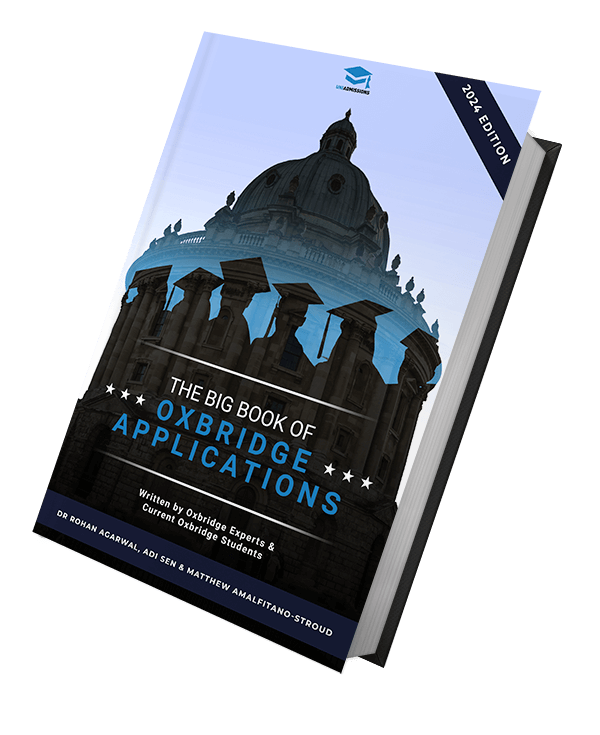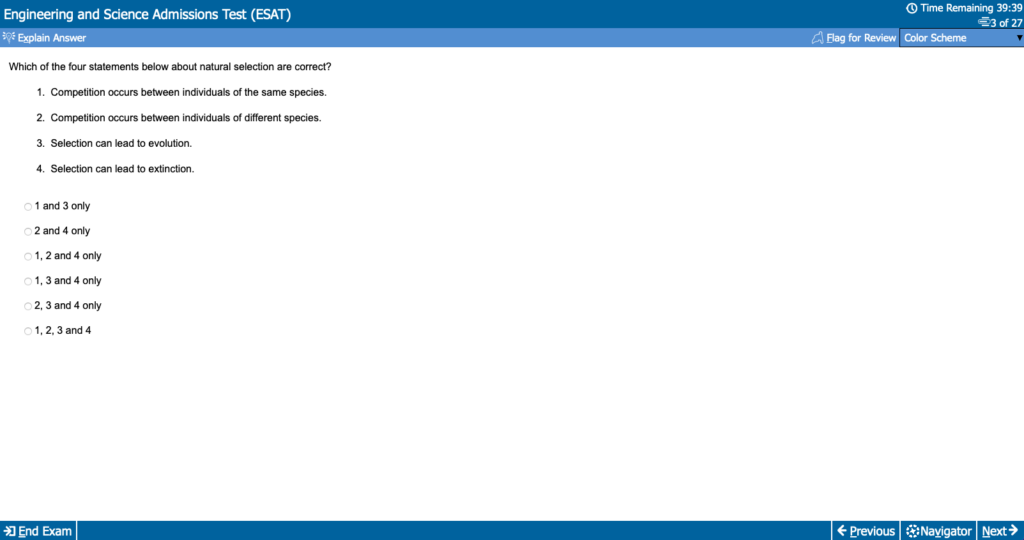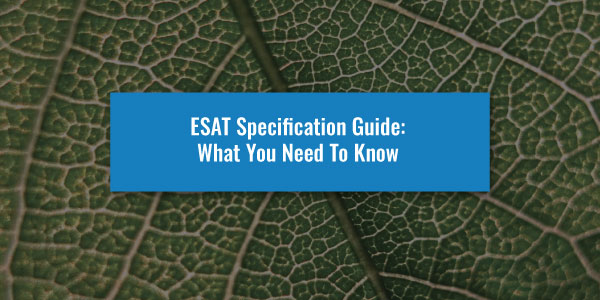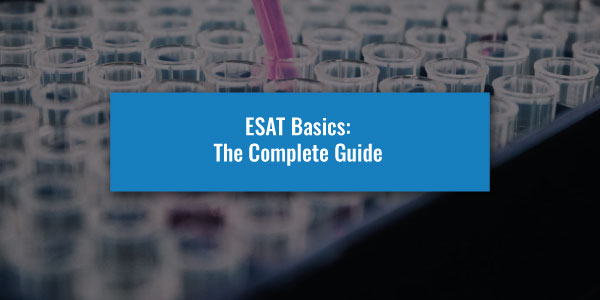2024 saw a lot of changes to the Oxbridge admissions testing space that have altered the way prospective students approach their applications. Changes in formats, specifications and the move to computer-based testing have all had an impact, and now we have multiple admissions tests with many similarities and even more differences.
One of the biggest changes in question was the introduction of the Engineering and Science Admissions Test (ESAT) at the University of Cambridge, which replaced two former exams (NSAA and ENGAA). The ESAT acts as a general STEM admissions test that now stands alongside Oxford’s Physics Admissions Test (PAT) and Mathematics Admissions Test (MAT).
These tests are fairly similar to each other, but there are a large number of differences to consider that may impact your university decision-making process. In this guide, we’ll explore exactly how the ESAT compares to Oxford’s two older admissions tests to see if you should take one over the other. Let’s begin!
ESAT vs PAT: An Overview
There are four primary categories of differences between the ESAT and PAT/MAT:
The ESAT is required by two different universities, more than the Oxford-exclusive PAT, but less than the MAT.
These tests are now computer-based, but the testing dates have been approached differently.
The ESAT is a multi-section test made up of MCQs, while some of Oxford’s tests feature more written questions.
The ESAT has a larger specification due to its broader scope compared to the PAT and MAT, which are subject-specific.
Let’s take a closer look at how these tests differ from one another in each of these categories.
Build an Oxbridge-quality Engineering application with support from UniAdmissions
Whether you’re applying to Oxford or Cambridge, UniAdmissions will guide you through the whole process to ensure you have the best chance of success. Through tuition, intensive courses, extensive materials and much more, you’ll have everything you need to work through your application with confidence.
Discover our Oxbridge Engineering Programmes below and find out how you can enrol and triple your chances of success.
ESAT Vs PAT: Usage
Firstly, let’s look at how each of these tests is actually used. This relates to which universities use each test and how they use it within the application process.
ESAT Usage
The usage of the ESAT is very different to both the PAT and MAT. Both of these tests are aimed at one specific subject (Physics and Mathematics), while the ESAT is a much more general STEM admissions test, meaning it can be used in more contexts.
It’s used by two universities in the UK; the University of Cambridge and Imperial College London. In both cases, the university requires an ESAT score to be submitted for your application to be considered. Below are the courses that require the ESAT:
It’s worth noting that some courses use the ESAT slightly differently than others due to the applicant’s ability to choose two sections to complete (see more in the format section). Engineering at Cambridge doesn’t let applicants make this choice, instead requiring specific subtests be taken.
PAT Usage
The PAT is exclusively used at the University of Oxford for the following courses:
The PAT is a requirement for each of these courses before interview invitations are sent out and there’s no variance in how the test results are used other than potential differences in standards at different colleges.
MAT Usage
The MAT is primarily used at the University of Oxford, but it is also required by Imperial College London and accepted by the University of Warwick for the following courses:
- (G100) Mathematics (Oxford, Imperial, Warwick)
- (GG14) Mathematics and Computer Science (Oxford)
- (GV15) Mathematics and Philosophy (Oxford)
- (GG13) Mathematics and Statistics (Oxford)
- (G400) Computer Science (Oxford)
- (IV15) Computer Science and Philosophy (Oxford)
Unlike the MAT, the ESAT isn’t used for any mathematics or computer science courses (the TMUA is used instead for this at Cambridge). Both tests are used at Imperial College London as well as their respective Oxbridge unis (Imperial uses the MAT for similar courses as Oxford). However, the MAT is also accepted at several other universities, though submission of an MAT score isn’t required at these. The ESAT isn’t currently used at any other unis.
ESAT Vs PAT: Presentation
Most Oxbridge admissions tests (including the subjects of this guide) are now operated by Pearson VUE, meaning they are computer-based and taken on specific Pearson VUE testing software at dedicated test centres. There are similarities in how these tests have evolved too, as the old style of PAT and MAT were paper-based, just like the NSAA and ENGAA (the ESAT’s predecessors).
Tests are to be sat on different days, with the PAT and MAT having a much longer teasing window than the ESAT.
ESAT Key Dates
| Event | Date |
|---|---|
| ESAT Registration Opens (October Sitting) | August 1st 2024 |
| ESAT Registration Closes (October Sitting) | September 16th 2024 |
| ESAT Testing Dates (October Sitting) | October 15th -16th 2024 |
| ESAT Registration Opens (January Sitting) | October 24th 2024 |
| ESAT Registration Closes (January Sitting) | December 9th 2024 |
| ESAT Testing Dates (January Sitting) | January 7th – 8th 2025 |
PAT & MAT Key Dates
| Event | Date |
|---|---|
| Test Registration Opens | August 15th 2024 |
| Test Registration Closes | October 4th 2024 |
| Testing Period Starts | October 21st 2024 |
| Testing Period Ends | October 31st 2024 |
The PAT and MAT can be taken over ten days, but there’s only one testing period for these tests. The ESAT has a second testing period in January, but this can only be used by Imperial College London Applicants.
Access "The Big Book Of Oxbridge Applications" For FREE
No matter which test you’re taking, you need to be prepared for the whole of your Oxbridge application. Start your preparation journey with The Big Book Of Oxbridge Applications, available for free here! Through over 350 pages, you will find:
- Over 40 admissions test practice questions
- 28 example Oxbridge Personal Statements
- Interviews with Oxbridge students and graduates
- Additional downloadable resources
Fill in your details below to claim your digital copy today!

ESAT Vs PAT: Format
The ESAT has a significantly different structure from the PAT and MAT as it’s heavily inspired by Cambridge’s previous STEM admissions test, the Natural Sciences Admissions Assessment (NSAA).
ESAT Format
The ESAT is split into five parts, or subtests, covering five different subjects.
ESAT Parts
- Mathematics 1
- Mathematics 2
- Physics
- Chemistry
- Biology
Applicants are required to take three of these subtests. Mathematics 1 is mandatory for all applicants, but the other two subtests are either selected by the applicant or pre-set depending on which subject you’re applying for.
The test lasts two hours (40 minutes per section) and you’ll have to complete 81 questions in total (27 in each subtest). Calculators and other materials aren’t permitted.
All of these questions are multiple-choice and worth one mark. Final scores are converted from raw marks on a scale that varies from year to year.
PAT Format
The PAT previously consisted of three types of questions (Multiple-Choice, Written, Multi-Part), which were each worth a different amount of marks. However, in 2024, the PAT will only contain Multiple-Choice Questions. This decision has likely been made due to the move to a computer-based format following Oxford’s partnership with Pearson VUE in 2024.
Currently, we don’t know exactly how many questions are in this new PAT format, but we do know that the test will last 2 hours. Unlike the ESAT, the PAT wasn’t presented in a section/subtest format, meaning all the questions were available in one, uninterrupted block. A simple digital calculator is included within the testing system, unlike the ESAT or MAT. Additional materials aren’t allowed.
The scoring system is also fairly different, though we don’t currently know how many marks each question will exactly be worth (previously, MCQs were worth 2 marks each). The papers always have 100 marks available in total.
MAT Format
Both the MAT and PAT have faced changes in their formats and requirements due to the Pearson VUE partnership, which meant that all Oxford admissions tests would be computer-based rather than taken on paper.
The MAT had a heavy emphasis on written questions pre-2024, so the format was changed to accommodate the new computer-based format. The test now features 27 questions, 25 of which are multiple-choice. The other two are longer written questions that are worth multiple marks. The test lasts 2 hours and 30 minutes and no supporting materials (including calculators) are permitted.
We currently don’t know exactly how many marks each question will be worth, but the test was previously scored in the same manner as the PAT. For the longer written questions, applicants will receive marks on both their solution and their method, so it’s important that you clearly explain your work.
ESAT Vs PAT: Specification
The final major difference between the ESAT and the PAT/MAT is the specifications (or syllabus). If you’re not aware, these are essentially documents that detail everything that could come up in the test, known as required knowledge.
Since these exams are designed for different purposes, the variance between them makes sense, but it’s still worth considering as it may impact your university decision.
ESAT Specification
The ESAT Specification is split into five distinct sections; one for each of the subtests. The first four subtests all cover required knowledge at roughly GCSE level, with many basic concepts outlined alongside more advanced topics. However, most of what’s covered here is at a much lower level than you would be expected to know at Oxbridge.
Mathematics 2 is the exception to this, which builds upon the Mathematics 1 section with new topics and principles to learn. This subtest is aimed more at those who study maths at A-Levels (or equivalents), so the required knowledge is more advanced as well.
The ESAT has one of the broadest specifications of any admissions test in the UK as it has to cover four distinct subjects (plus one advanced version). However, since you only need to sit three subtests, you won’t need to revise everything in the document – only the required knowledge for your chosen subtests.
It’s worth noting that the ESAT specification is actually built from the NSAA specification used in 2023. There were very few changes made between the NSAA and ESAT specifications other than the removal of advanced required knowledge for Physics, Chemistry and Biology. These functioned the same as the Mathematics 2 specification but were taken out because the advanced science subtests from the NSAA were removed for the ESAT.
We outline everything included in this document in our ESAT Specification Guide, so be sure to check it out if you want to know what to revise for the test.
PAT Syllabus
Since the PAT is an admissions test for physics-based degrees, the required knowledge for this admissions test is based on Physics and Mathematics. Unlike the ESAT specification, which is spread across 46 pages, the syllabus for the PAT is far more basic.
Instead of listing every concept that could be covered, the PAT simply states which major topics will be tested, alongside a few essential skills and equations. This true of both the maths and physics sections, although the physics syllabus does feature more detailed explanations.
How does the content compare to the relevant sections of the ESAT? Here are a few key differences:
- The PAT places a strong emphasis on calculus, which isn’t discussed in the ESAT specification.
- Most content seen in the ESAT's Mathematics 1 specification is summed up by the PAT in a single bullet point, referred to as “elementary mathematics”
- The PAT physics syllabus features a section called “Natural World” which is a summation of much of the content included in the ESAT specification. This includes forces, matter and planets, which is a topic that’s not covered in the ESAT.
- Some topics from the ESAT don’t feature in the PAT, such as radioactivity and thermal physics.
- The PAT features a small section for “Problem-Solving”, a general skill which isn’t detailed within the ESAT specification.
While the PAT syllabus is less detailed and generally features fewer topics, we can see that the actual content (specifically for physics) is more advanced, meaning questions will tackle harder topics and concepts.
MAT Syllabus
The MAT Syllabus is the shortest of the three documents as it only takes up a single page. This makes sense as it only covers one subject, but it’s still significantly smaller than the ESAT’s Mathematics 1 and 2 specifications.
Like the PAT, the MAT covers mathematics at a higher level, roughly around the same level as Mathematics 2 in the ESAT. Part of the reason that the MAT syllabus is so short is because it doesn’t feature basic knowledge that would be required to understand what’s actually featured. This includes entries such as units and basic functions.
The MAT also doesn’t feature topics such as statistics and probability, suggesting that questions relating to these topics won’t feature in the test. The content that does feature is very similar to the ESAT’s Mathematics 2, so the question topics in the two exams should be fairly similar.
Which Admissions Test Should I Take?
This is a question that you may be asking, but this isn’t necessarily the correct approach to take for your application. The admissions test you take will depend on the course you apply for, so the real questions you should be asking yourself are:
- Which course/university do I most want to attend?
- Am I confident enough in myself and my application to get a good score?
None of these admissions tests are arbitrary tasks as they each give you a preview into the level of understanding and ability that will be expected of you during your studies. If one of these tests seems overwhelmingly difficult to you, then you’re most likely not working at a high enough standard to be successful at the university you’re applying for.
This isn’t to say that you shouldn’t be worried or think that the tests are difficult – they’ll be some of the most difficult exams you’ve taken thus far! These tests are purposely challenging to help the universities find the applicants that would perform best within their courses, so it’s up to you to rise to that challenge and prove you’ve got what it takes, no matter how difficult.
To reiterate, the decision of which exam you take should come down to the course you want to apply to and how confident you are in your ability to succeed in the whole application process, not just the admissions test. If your mind is set on a certain course, then the test you take will be the right one for you.
Which Test Is Harder?
The difficulty of admissions tests will always be somewhat subjective as it will come down to each applicant’s skills and preferences. However, looking at the format and specification of each exam, we can see that the PAT and MAT could be considered objectively harder than the ESAT for two reasons.
Firstly, the ESAT is entirely built of Multiple-Choice Questions. While these are still challenging to get right, having potential answer options available to view gives test-takers a hint as to what the solution should be. It also allows test-takers a greater chance of earning marks on questions they can’t solve, as they have the ability to select a random answer without any working out.
As of 2024, this is also true of the PAT, which previously used a mixture of MCQs and written questions. However, the MAT will still feature 2 written questions that will need to be completed. This means that, in this regard, the MAT will be the hardest test of the three.
The second reason is due to each test’s specification/syllabus. We’ve already seen that the ESAT has large specification that covers five different subtests and features over 40 pages of required knowledge. However, all of this knowledge (excluding Mathematics 2) is taught at a fairly low level and would be considered fairly basic by A-Level standards.
This isn’t the case for the PAT and MAT, which each test applicants on topics taught in A-Levels. This means that the content of the questions in these tests is generally going to be harder. When combined with the use of longer questions, it can easily be argued that these tests are harder than the ESAT.
However, one argument that could suggest that the ESAT is harder is the scope of the test. Each applicant is required to complete three subtests (one of which is Mathematics 1), meaning applicants may need to revise for up to three separate subjects. The MAT is solely focused on mathematics and the PAT only tests maths and physics ability, so your revision for these tests can be far more focussed.
Another factor that specifically makes the PAT easier is that it’s the only one of the three exams to allow the use of calculators. Instead of bringing a calculator to the test, a digital calculator will be available within the testing system. This isn’t the case for the ESAT or MAT.
As we said, the difficulty of a test comes down to personal preference. If you’re well-versed in all of the core sciences and mathematics, the ESAT may be easier for you, whereas if you’re highly skilled in just mathematics or physics, the PAT and MAT may be easier.
Can I Take Both Tests?
There’s one strict rule that every Oxbridge applicant must adhere to; you cannot apply to both Oxford and Cambridge in the same application cycle. Therefore, as an example, you won’t be taking both the PAT for Oxford Engineering Science and the ESAT for Cambridge Engineering, as you aren’t allowed to apply for both courses in the same year.
However, with recent changes to Oxford and Cambridge admissions tests (including the introduction of the ESAT), you’re now much more likely to have to sit both admissions tests.
As an example, you may wish to apply for one of the various engineering degrees at Imperial College London, which requires an ESAT score to be submitted. You may also want to apply to Oxford Engineering Science, which requires the PAT. Since there’s no rule against applying to these two universities in the same year, you’ll now have to take both of these admissions tests.
Similar situations can arise with the MAT, which is accepted by multiple universities, as well as the Test of Mathematics for University Admission (TMUA) and Sixth Term Examination Papers (STEP). Essentially, you are now more likely than ever to have to complete two admissions tests in one application cycle, something that was typically reserved for medicine applicants before the removal of the BMAT in 2024.
That’s just about everything you need to know about the differences between the ESAT and PAT/MAT. Overall, they’re fairly different exams despite having roughly the same purpose. It shows how Oxford and Cambridge choose to tackle their admissions in different ways and provide different options for applicants.
No matter which exam you’re taking, it’s important that you spend the proper amount of time and energy to prepare yourself for the testing day. Revision and practice are both crucial parts of the preparation process, but it can be hard to organise everything yourself on top of the rest of your application and school work.
If you’re looking for extra support with your admissions test, discover our ESAT Programme, PAT Programme and MAT Programme to learn how working with UniAdmissions drastically increases your chances of success. Each programme is built upon our winning formula for success and is comprised of top-class components including one-to-one tuition, live courses, extensive material and more.
We wish you the best of luck with your admissions test and your application as a whole!
Earn your offer for Oxford or Cambridge Engineering with UniAdmissions
At UniAdmissions, we have over a decade of getting applicants into Oxbridge to study over 50 subjects, including Engineering. Our formula for success, built upon our six pillars of support, offers everything you need to build a strong application and become an ideal Oxbridge student.
Discover our Oxbridge Engineering Programmes below and find out how you can enrol and triple your chances of success.








